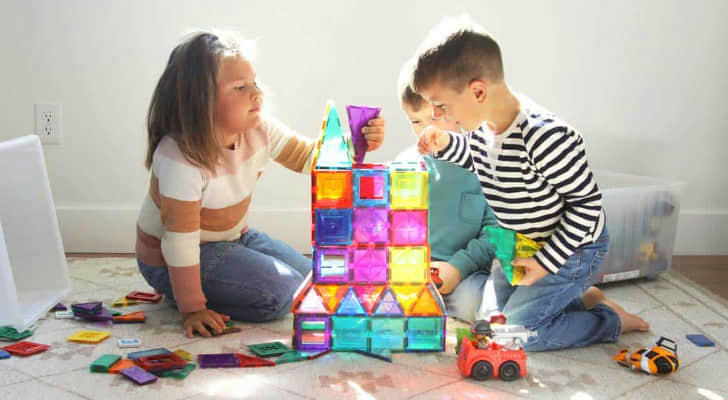10 Fun Home Activities to Boost Your Child's Speech Development

Approximately 8% of young children in the United States experience communication difficulties. A speech and language delay occurs when a child is not progressing in their speech and language abilities as expected. Various factors can contribute to these delays. If you suspect your child is struggling with communication, it’s crucial to consult a professional, such as a speech-language therapist. This article will offer tips and activities to enhance your child's speech development at home. Read on to learn more!
Activities to Enhance Speech and Language Skills at Home
Let's explore different activities and tips that can help nurture your child’s speech and language skills. As your child’s primary teacher, implementing these strategies will not only kickstart their learning journey but also equip you with valuable insights into teaching fundamental concepts
1. Engage in Daily Playtime
Play is an essential tool for learning. Through play, children can grasp various concepts like colors, animal names, and actions. Dedicate at least 30 minutes to an hour each day for undistracted playtime. Your presence and involvement are the most valuable gifts you can offer to foster your child's ability to identify and use different toys appropriately. Children can have numerous toys, but without your active participation, they may miss out on learning new things.
2. Simplify Toy Selection

Children don’t require an abundance of toys. Focus on choosing open-ended toys that can be used in various ways and encourage social interaction. However, spending time outdoors is even more beneficial! Outdoor activities can spark creativity and imagination, allowing children to think more freely and stay active. Nature engages multiple senses; children can see, hear, smell, and touch the environment around them, enhancing their sensory experiences.
3. Enjoy Reading Together
One of the best activities to support speech development at home is reading books. Books with vibrant pictures can captivate your child’s attention while introducing new concepts. When reading, ask questions and leave out predictable words, such as animal sounds, to encourage your child to participate. Reading together also strengthens problem-solving skills, which boosts cognitive and imaginative abilities.
Besides fostering a bond between you and your child, reading increases their attention span. Initially, your child might get distracted or fidget during storytime, but over time, they will learn to stay engaged for the duration of the book.
4. Teach Emotions and Feelings

Helping your child understand and manage their emotions is crucial for their development. As young children begin to communicate, they might experience frustration easily. Research indicates that children use the right side of their brain, where emotions are processed, during overwhelming experiences, which often leads to tears. Teaching them to recognize and validate their feelings—such as happiness, sadness, anger, frustration, jealousy, surprise, and fear—helps them cope more appropriately.
For example, if a doctor’s appointment feels intimidating, reassure your child by saying, “It’s okay to tell me how you feel, but this is important for your health.” Consistently teaching and regulating emotions is essential for their mental well-being.
5. Introduce Colors
Children typically begin learning colors between 18 to 29 months. While some may grasp colors earlier or later, this age range is ideal for introducing them. Start with primary colors like yellow, red, green, and blue. Once your child masters these, introduce other colors of the rainbow. Remember, repetition is vital for mastery.
Activities to teach colors and enhance speech development include:
•Coloring books
•Singing songs like the Rainbow Song or the Color Song
•Playing with colorful blocks or balls
•Grouping objects by color
•Using playdough
6. Introduce Sign Language

As your child begins to learn to speak, they might struggle to communicate their needs, often using the same sounds for different purposes. Teaching them basic sign language can be a helpful tool for expressing their wants and needs.
Far from hindering their verbal development, sign language can actually support it by providing an additional means of communication. Simple signs like “more,” “help,” and “please” can help reduce frustration and improve their ability to express themselves. Over time, this can pave the way for more effective verbal communication.
7. Place Items Out of Reach
A useful technique to encourage your child to use their communication skills is to place desired toys, snacks, and activities in visible but inaccessible spots. This strategy motivates them to use their words or gestures to ask for what they want.
Position these items on high shelves or inside clear bins so your child can see them but not easily grab them. For items that are stored away, keep them behind cabinet doors or in containers. This approach helps your child practice requesting items and reinforces their communication efforts rather than giving them unrestricted access.
8. Sing Along
Incorporating music into your child’s routine can be an effective way to enhance their learning. Singing children’s songs and nursery rhymes can boost their mood and make learning fun. Music encourages speech development by making the learning process engaging and memorable. It also aids in concept learning and memory practice.
9. Use Daily Routines as Learning Opportunities
Daily activities like bathing, eating, and dressing provide excellent chances to teach new concepts. Repetition is key, so use these routine moments to reinforce language skills. The more frequently you introduce and practice new concepts, the more likely your child is to remember and use them.
10. Practice Self-Talk

Self-talk is a valuable technique in speech therapy. It involves verbalizing your actions and observations to provide your child with descriptive language models. For instance, if you’re playing with a ball, you might say, “This is a ball. I am bouncing the ball. The ball is round and blue. I enjoy playing with the ball. Oh, I heard a thud!”
Keep your descriptions simple and short, matching your child’s language level. Repeating these descriptions helps your child learn and understand language better. If your child is using single words, speak in one- or two-word phrases. As they progress, incorporate slightly longer phrases to model more complex speech patterns.
Knowing When to Get Expert Assistance
While engaging in various activities to support your child’s speech development is valuable, there are times when it’s important to seek professional guidance. If you notice that your child is not making progress at a rate that is typical for their age, it may be time to consult a specialist.
A speech-language therapist can assess your child’s speech and language abilities to identify any issues or delays. Early intervention is key to addressing these challenges effectively. The sooner you get a professional evaluation, the sooner your child can receive targeted support, leading to better outcomes.
